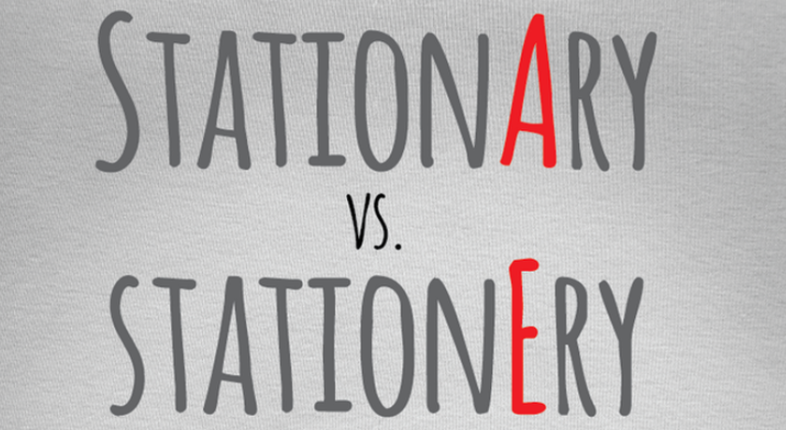Stationery vs Stationary: A Guide to Proper Usage
Contents

The Intriguing Case of Stationery vs Stationary
Are you often confused about the difference between stationery and stationary? Don't worry, you're not alone! Many English learners struggle with these two words due to their similar spellings and pronunciations.
When it comes to stationery and stationary, the confusion lies in their meanings and usage. They may sound alike, but they have completely different definitions.
This article aims to provide you with a clear understanding of when and how to use these words correctly. By the end of this guide, you will be able to confidently distinguish between stationery and stationary in your everyday English conversations and writing.
Now that we've set our goal for this article, let's dive deeper into the differences between stationery and stationary.
What is the Difference between Stationery and Stationary?
When it comes to the English language, two words that often cause confusion are "stationery" and "stationary". Though they sound similar, their meanings are quite different. Let's delve into each term to understand their distinctions.
1) Definition and Explanation of "Stationery":
Stationery refers to a wide range of writing materials, office supplies, and paper products that are commonly used for writing, drawing, or other forms of communication. This includes items such as pens, pencils, erasers, notebooks, envelopes, notepads, and much more. Stationery is an essential part of our daily lives and is often used at school, work, or when sending letters or invitations.
To better understand how to use the term "stationery" correctly in sentences, take a look at the following examples:
I need to buy some new stationery for school. (referring to various writing materials)
She owns a beautiful collection of personalised stationery. (referring to customised paper products)
The office supply store offers a wide range of stationery products. (referring to different office supplies)
Now let's move on to understanding the term "stationary."
2) Definition and Explanation of "Stationary":
Stationary refers to something that is not moving or at rest. It describes objects or things that remain fixed in place without any motion. This term is commonly used to describe vehicles, machinery, or even fans.
Here are some examples illustrating the correct usage of the term "stationary":
The car stood stationary at the red light. (referring to a vehicle not in motion)
Please keep your vehicle stationary while waiting for assistance. (advising someone to keep their vehicle still)
The fan remained stationary on the ceiling. (describing a fan that is not moving)
Understanding the difference between stationery and stationary is crucial for using these terms correctly in various contexts. By checking out more stationery vs stationary examples, you can enhance your communication skills and express yourself more effectively.

Pronouncing Stationery vs Stationary
When it comes to pronouncing "stationery" and "stationary", many learners may wonder if these two words are pronounced the same way or if there is a difference. Let's explore the different pronunciations for both "stationery" and "stationary" in US, UK, and Indian English.
It's important to note that despite their differences in spelling and meaning, these two words are homophones. This means that they are pronounced the same way, even though they have distinct meanings. So when you say either word aloud, they should sound identical!
In all three varieties of English, the word "stationery" is pronounced as /ˈsteɪʃən(ə)ri/. The stress falls on the second syllable in all cases.
On the other hand, the word "stationary" is also pronounced as /ˈsteɪʃəˌnɛri/ in US and UK English. However, in Indian English, it can be pronounced as /stɛɪʃəˌnari/. Again, the stress falls on the second syllable.
So we can see there is a slight variation that may or may not be very evident depending on the region and accent.
To summarise:
"Stationery": /ˈsteɪʃən(ə)ri/ (US, UK, Indian English)
"Stationary": /ˈsteɪʃəˌnɛri/ (US, UK English), /stɛɪʃəˌnari/ (Indian English)
Keep practising and perfecting your pronunciation skills to ensure your spoken English sounds natural and fluent.
Never Confuse Stationery with Stationary Again!
Many people stumble upon these two words due to their similar pronunciation and visual appearance. We have a helpful memory aid that will make sure you never confuse stationery with stationary again.
Visual Associations
To remember the difference between stationery and stationary, let's use a visual association technique. Picture yourself standing in a stationery store, surrounded by beautiful pens, notebooks, and colourful paper. The letter 'e' in stationery stands for 'envelope' or 'eraser', items you can find in a stationery store. On the other hand, imagine yourself standing beside a statue that is completely still – just like the last three letters in stationary.
Flashcards
Creating flashcards can be an effective way to reinforce your understanding of the difference between these two words. On one side of the flashcard, write "stationery" and on the other side write "stationary." Add relevant examples or visuals to each side to enhance your memory recall. Practice reviewing these flashcards regularly until you feel confident in distinguishing between the two words effortlessly.
Online Resources
In addition to flashcards, there are several online resources available that can help you practice and solidify your knowledge of stationery vs stationary meaning and usage. Websites like Clapingo offer interactive exercises and quizzes specifically designed for English language learners. Take advantage of these videos and resources to test your understanding and improve your skills at your own pace.
By using this memory aid and practising with flashcards or online resources, you'll soon become an expert in differentiating between stationery and stationary.
Translations and Interpretations in Indian Languages
As we delve into the topic of stationery vs stationary, it's essential to understand how these words are translated and interpreted in popular Indian languages. Here is a table listing the translations and interpretations of these terms:
Language | Translation of "Stationery" | Translation of "Stationary" |
Hindi | कागज का सामान (kagaj ka saman) | अवस्थित (avasthit) |
Tamil | மாடிச்சை (maadichchai) | நிலையான (nilaiyaana) |
Telugu | ఆశ్రయించుట (aashrayinchutu) | స్థైర్యం పొందిన (sthairyam pondina |
Bengali | একধরনের কাগজের প্রকার (ekdhonner kagajer prokar) | অবিচলিত অবস্থায় আছে (obicholito obosthaye ache) |
Kannada | ಸಾಮಾನ್ಯ ಬಣ್ಣದ ಕಾಗದು (samaanya baṇṇada kāgadu) | ಸ್ಥಿರವಾದ (sthira vaada) |
Malayalam | കാഗത പൊരുത്തപ്പെടുന്ന (kaagatha poruthappetunna) | സ്ഥിരാവസ്ഥ (sthiravastha) |
This table provides approximate translations and interpretations in Hindi, Tamil, Telugu, Bengali, Kannada, and Malayalam. It's important to note that these translations may vary slightly depending on the context in which the words are used.
By understanding these translations and interpretations, you can effectively communicate the correct stationery vs stationary meaning in popular Indian languages. Remember, it's essential to use the appropriate word based on the context in which you are speaking or writing.
Final Thoughts
Congratulations on completing this guide to proper usage of stationery vs stationary! Let's recap the key points we've discussed:
Stationery refers to writing materials such as paper, pens, and envelopes, while stationary means not moving or fixed in one place. Remember the spelling difference - "a" for stationAry and "e" for stationEry. Many English learners often confuse these words due to their similar pronunciation. However, by understanding their distinct meanings, you can avoid making these errors in your writing.
Now that you have a clear understanding of the difference between stationery and stationary, it's time to put your knowledge into practice! At Clapingo's online platform, we offer a wide range of resources and courses tailored to help you improve your English language skills. Whether you want to learn perfect sentence formation in English online or searching for the perfect fluent English speaking course, Clapingo has got you covered.
FAQs
1. What is the difference between stationery and stationary?
Stationery refers to writing materials such as paper, pens, pencils, envelopes, and other office supplies. On the other hand, stationary means not moving or fixed in one place. So, while stationery is related to writing materials, stationary refers to something immobile or still.
2. Is paper stationery or stationary?
Paper falls under the category of stationery. It is a common writing material used for letters, notes, sketches, and more. When you think of stationery, paper is often the first thing that comes to mind.
3. Is school stationary or stationery?
School supplies can be considered as both stationery and stationary items depending on their purpose. Notebooks, pencils, erasers, rulers, and other writing materials fall under the category of stationery as they are used for learning and communication purposes. However, desks, chairs, and blackboards are examples of stationary objects as they remain fixed in one place within a classroom.
4. Is stationary ever used as a noun?
No, "stationary" primarily functions as an adjective, meaning not moving or fixed in one place.
Comments
Your comment has been submitted